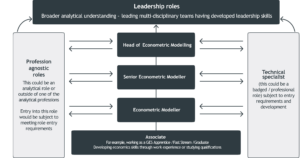Role profile: econometric modeller
Econometric modellers work either in teams of economists or wider, multi-disciplinary teams. They run models, including Computable General Equilibrium (CGE) or partial equilibrium for scenario analysis in software packages.
Econometric modellers are technical specialists with lots of experience, relevant qualifications in economics, or analytical professional membership.
Typical role responsibilities
Econometric modellers:
- develop and maintain econometric models
- design, create, test and refine econometric or statistical models using appropriate software packages
- analyse data using appropriate software packages
- produce and communicate analysis
Skills
You must have a strong understanding of economic theory.
You will be expected to demonstrate these skills at different levels depending on the seniority of your role.
Econometric modeller
As an econometric modeller, you must have an ‘awareness’ skill level.
Senior econometric modeller
As a senior econometric modeller, you must have a ‘practitioner’ skill level.
Head of econometric modelling
As a head of econometric modelling, you must have a ‘practitioner’ skill level.
You must have a strong understanding of mathematical and statistical modelling approaches.
You will be expected to demonstrate these skills at different levels depending on the seniority of your role.
Econometric modeller
As an econometric modeller, you must have an ‘awareness’ skill level.
Senior econometric modeller
As a senior econometric modeller, you must have a ‘practitioner’ skill level.
Head of econometric modelling
As a head of econometric modelling, you must have an ‘expert’ skill level.
You must have excellent communication and interpersonal skills. This includes the ability to clearly and confidently communicate complex analysis to specialists and non-specialists. You must be able to communicate effectively both verbally and in writing, or visual formats.
You will be expected to demonstrate these skills at different levels depending on the seniority of your role.
Econometric modeller
As an econometric modeller, you must have an ‘awareness’ skill level.
Senior econometric modeller
As a senior econometric modeller, you must have a ‘practitioner’ skill level.
Head of econometric modelling
As a head of econometric modelling, you must have an ‘expert’ skill level.
You must be able to interpret requirements and use graphical representations and data visualisations to present data in a clear and compelling way.
You will be expected to demonstrate these skills at different levels depending on the seniority of your role.
Econometric modeller
As an econometric modeller, you must have an ‘awareness’ skill level.
Senior econometric modeller
As a senior econometric modeller, you must have a ‘working’ skill level.
Head of econometric modelling
As a head of econometric modelling, you must have a ‘practitioner’ skill level.
You must be able to run models in software packages.
You will be expected to demonstrate these skills at different levels depending on the seniority of your role.
Econometric modeller
As an econometric modeller, you must have an ‘awareness’ skill level.
Senior econometric modeller
As a senior econometric modeller, you must have a ‘working’ skill level.
Head of econometric modelling
As a head of econometric modelling, you must have an ‘expert’ skill level.
You must be able to use analytical skills and analytical software to present well-founded results and recommendations to support decision-making.
You will be expected to demonstrate these skills at different levels depending on the seniority of your role.
Econometric modeller
As an econometric modeller, you must have an ‘awareness’ skill level.
Senior econometric modeller
As a senior econometric modeller, you must have a ‘practitioner’ skill level.
Head of econometric modelling
As a head of econometric modelling, you must have an ‘expert’ skill level.
Sample career path
The econometric modeller career path shows some of the common entry and exit points for the role. It also shows the typical skill levels needed.
You can enter an econometric modeller role from another analytical profession, or from other professions. You can also exit the role to join another profession.

The diagram shows a potential career path. It shows that you can enter or leave a role from a wide range of backgrounds and experience levels. For example, you could become an econometric modeller by developing your skills in an associate role. You could continue to move up the levels in the career path by taking on more senior econometric modeller roles. Or you could develop your skills by working in a technical specialist role in an analytical or digital profession. You could also develop the necessary skills by working in a profession agnostic role outside of these professions.
A role that could be done by any person with the relevant skills or experience from any profession.
This could be a ‘badged’ or professional role that is subject to entry requirements and development.
Beyond the head of econometric modelling role, you could go into more senior leadership roles. These roles require broader analytical understanding, and the ability to lead multi-disciplinary teams.
